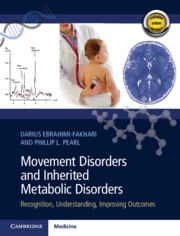Book contents
- Movement Disorders and Inherited Metabolic Disorders
- Movement Disorders and Inherited Metabolic Disorders
- Copyright page
- Dedication
- Contents
- Contributors
- Preface
- Acknowledgments
- Section I General Principles and a Phenomenology-Based Approach to Movement Disorders and Inherited Metabolic Disorders
- Chapter 1 Treatable Metabolic Movement Disorders: The Top 10
- Chapter 2 The Importance of Movement Disorders in Inborn Errors of Metabolism
- Chapter 3 The Importance of Inborn Errors of Metabolism for Movement Disorders
- Chapter 4 Imaging in Metabolic Movement Disorders
- Chapter 5 Biochemical Testing for Metabolic Movement Disorders
- Chapter 6 Genetic Testing for Metabolic Movement Disorders
- Chapter 7 A Phenomenology-Based Approach to Inborn Errors of Metabolism with Ataxia
- Chapter 8 A Phenomenology-Based Approach to Inborn Errors of Metabolism with Dystonia
- Chapter 9 A Phenomenology-Based Approach to Inborn Errors of Metabolism with Parkinsonism
- Chapter 10 A Phenomenology-Based Approach to Inborn Errors of Metabolism with Spasticity
- Chapter 11 A Phenomenology-Based Approach to Inborn Errors of Metabolism with Myoclonus
- Section II A Metabolism-Based Approach to Movement Disorders and Inherited Metabolic Disorders
- Section III Conclusions and Future Directions
- Appendix: Video Captions
- Index
- References
Chapter 4 - Imaging in Metabolic Movement Disorders
from Section I - General Principles and a Phenomenology-Based Approach to Movement Disorders and Inherited Metabolic Disorders
Published online by Cambridge University Press: 24 September 2020
- Movement Disorders and Inherited Metabolic Disorders
- Movement Disorders and Inherited Metabolic Disorders
- Copyright page
- Dedication
- Contents
- Contributors
- Preface
- Acknowledgments
- Section I General Principles and a Phenomenology-Based Approach to Movement Disorders and Inherited Metabolic Disorders
- Chapter 1 Treatable Metabolic Movement Disorders: The Top 10
- Chapter 2 The Importance of Movement Disorders in Inborn Errors of Metabolism
- Chapter 3 The Importance of Inborn Errors of Metabolism for Movement Disorders
- Chapter 4 Imaging in Metabolic Movement Disorders
- Chapter 5 Biochemical Testing for Metabolic Movement Disorders
- Chapter 6 Genetic Testing for Metabolic Movement Disorders
- Chapter 7 A Phenomenology-Based Approach to Inborn Errors of Metabolism with Ataxia
- Chapter 8 A Phenomenology-Based Approach to Inborn Errors of Metabolism with Dystonia
- Chapter 9 A Phenomenology-Based Approach to Inborn Errors of Metabolism with Parkinsonism
- Chapter 10 A Phenomenology-Based Approach to Inborn Errors of Metabolism with Spasticity
- Chapter 11 A Phenomenology-Based Approach to Inborn Errors of Metabolism with Myoclonus
- Section II A Metabolism-Based Approach to Movement Disorders and Inherited Metabolic Disorders
- Section III Conclusions and Future Directions
- Appendix: Video Captions
- Index
- References
Summary
During the evaluation of a patient with a movement disorder, advanced neuroimaging is often obtained to narrow the diagnostic possibilities and also to assess the status of what is frequently a neurodegenerative process. In the other chapters of this monograph, specific metabolic causes of movement disorders are discussed in detail. In this chapter, we provide a pragmatic approach for integrating imaging data into the work-up of a patient with a movement disorder of uncertain etiology, heavily emphasizing brain MRI which is the cornerstone of imaging work-up for this indication. Our focus is on pediatric-onset disorders manifesting as dystonia, chorea, athetosis, tremor, parkinsonism, and myoclonus.
- Type
- Chapter
- Information
- Movement Disorders and Inherited Metabolic DisordersRecognition, Understanding, Improving Outcomes, pp. 43 - 68Publisher: Cambridge University PressPrint publication year: 2020



